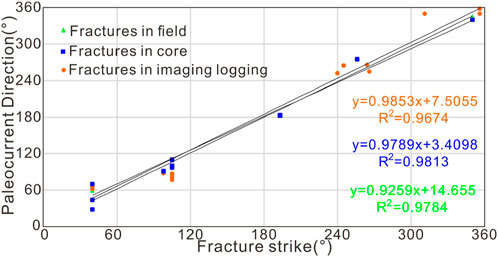Development or absence of conjugate fractures in low-permeability sandstones
- 1College of Earth Sciences and Engineering, Shandong University of Science and Technology, Qingdao, China
- 2School of Earth Resources, China University of Geosciences, Wuhan, China
- 3Tongren Zhongneng Natural Gas Co, Ltd, Tongren, China
- 4Institute of Geophysical and Geochemical Exploration, Chinese Academy of Geological Science, Tianjin, China
Natural fractures are ubiquitous in rocks. The Coulomb law of Mohr’s failure theory predicts that the angle between conjugate failure surfaces is a constant. In the Ordos Basin, observing the development of two groups of conjugate fractures in the field, cores and imaging logging is very difficult. In this paper, the directions of paleocurrents in the Upper Triassic Yanchang Formation of the Ordos Basin are determined by measuring the orientations of field bedding. Through the correlation analysis of paleocurrent and natural fracture orientations, when the sediment comes from a single source, a group of fractures with a large angle between conjugate fractures and the paleocurrent direction is found not to develop. When the sediments in the study area have two provenances, both provenance directions affect the development of conjugate fractures. In the southern Ordos Basin, influenced by the direction of paleocurrent flow in the near-north direction, fractures in the near N‒S direction develop. Through rock mechanics experiments in different directions, the planar anisotropy in rock mechanics parameters caused by the direction of paleocurrent flow is found to be the geological factor leading to various degrees of fracture development in different directions within the Ordos Basin.
1 Introduction
The occurrence of fractures plays a decisive role in quantifying the anisotropy of fractured reservoirs. The orientation of fractures is indicative for determining the migration and accumulation of oil and gas in different geological periods and is a prerequisite for accurately predicting the current fracture opening pressure, effective opening, permeability and other parameters (Zeng et al., 2008a; Liu et al., 2021; Li et al., 2022). The Coulomb law of Mohr’s failure theory predicts that the angle between conjugate failure planes is a constant, which is independent of the magnitude of the stress difference in rock failure, and that the maximum principal stress divides the angle equally (Muehlberger, 1961; Palchik, 2006; Li et al., 2019,2022; Chai and Yin, 2021; Wood, 2022). Experimental results show that the angle actually decreases with decreasing confining pressure (Muehlberger, 1961). A single group of fractures may have similar properties (types, mineral fillers, etc.) and specific direction range. Natural fractures are ubiquitous in rocks. Because of sedimentary changes, differential diagenesis and uneven stress distribution in sandstone reservoirs, the degrees of fracture development for different formations are different (Nelson, 2001; Zeng et al., 2008a; Laubach et al., 2009; Liu et al., 2018; Gong et al., 2019; Liu et al., 2022b, c). The vertical anisotropy of rock also affects the propagation paths of fractures, which are terminated, penetrated or turned near structural planes (Hutchinson, 1996; Gudmundsson, 2006; Gudmundsson et al., 2010; Larsen et al., 2010; Liu et al., 2019). According to the published literature (Zeng et al., 2008b; Jiang et al., 2016; Lyu et al., 2016; Gong et al., 2019; Fan et al., 2020; Fan et al., 2022), observing conjugate fracture development in the Ordos Basin is very difficult, whether in the field, cores or imaging logging. However, in the margin of the basin, where the value of tectonic differential stress is large, tectonic stress may be the dominant factor controlling the directions and paths of fracture propagation, and conjugate fractures can be seen in the field (Zhao and Hou, 2017a).
The Ordos Basin is one of the main areas of low-permeability sandstone reservoirs and is a key region for the exploration and development of low-permeability reservoirs in China (Liu et al., 2005; Yao et al., 2013; Zou et al., 2013; Tao et al., 2016). In the Ordos Basin, due to the influences of sedimentation, diagenesis and tectonism, the heterogeneity of low-permeability reservoirs is strong, and natural fracture development is affected by lithology, thickness and rock mechanics parameters (Zhao et al., 2014; Ju et al., 2017). Natural fractures control the seepage systems of low-permeability reservoirs, thus affecting the deployment of low-permeability oilfield development plans and their development (Zeng et al., 2007; Zeng et al., 2008a; Zeng and Li, 2009; Ju et al., 2015; Zhao and Hou, 2017a; Liu et al., 2022a; Chen et al., 2022). Therefore, studying the orientations of natural fractures and the factors that influence fracture orientation is very important for the deployment of an injection-production well pattern, the direction of water seepage in the reservoir, and the formulation of a reasonable development plan. In this paper, we provide an example of how the planar anisotropy of rock mechanics caused by sedimentation (paleocurrent direction) leads to variable fracture development in different directions in the Ordos Basin. Controlled by the direction of the paleocurrent, the planar anisotropy of reservoir mechanical parameters shows the lowest compressive strength parallel to the direction of the paleocurrent, which is an important factor affecting the diverse degrees of fracture development in different directions.
2 Geological settings and stratigraphy
The Upper Triassic Yanchang Formation in the Ordos Basin developed delta plains, delta fronts, semideep lakes and deep lake deposits (Liu and Yang, 2015). Controlled by sedimentary facies, the sand bodies are distributed in large areas on the plane. On the whole, the structural deformation of the reservoir in the basin is weak, the strata dips are gentle, and faults and folds have not developed (Figure 1). Outcrop observations around the basin indicate that the fractures in the Triassic and Jurassic strata are relatively developed. Therefore, although folds and faults are not present in the basin, the regional stress acting on the periphery of the basin has an impact on the interior of the basin, which is characterized by extensive regional fractures in the basin (Zeng et al., 2008a).
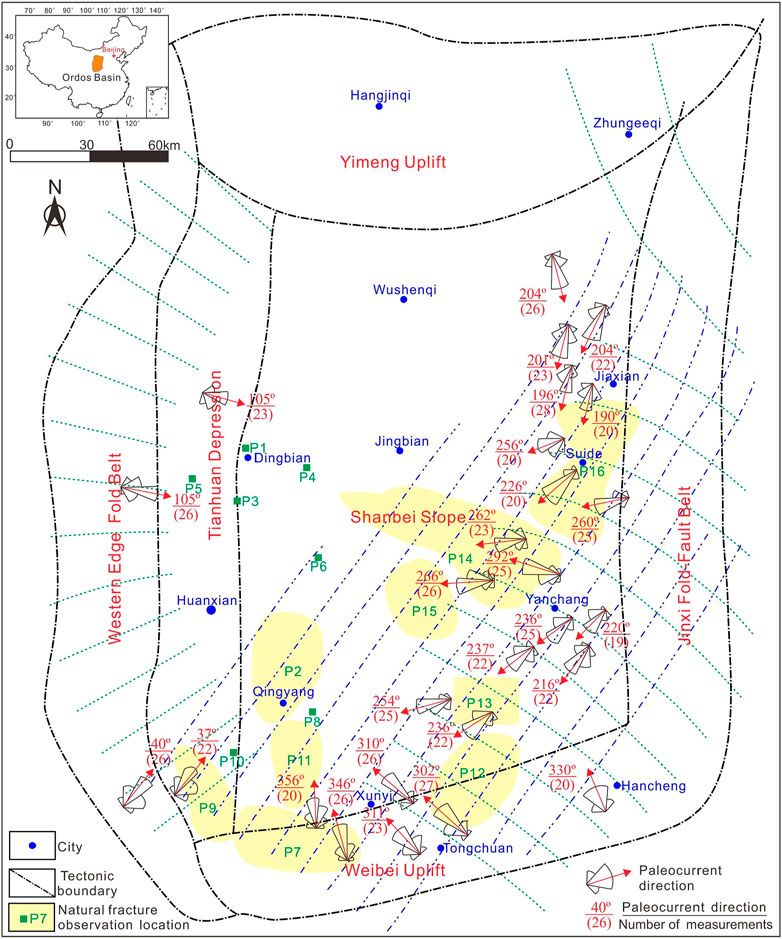
FIGURE 1. Distribution of the tectonic stress field and paleocurrents in the Ordos Basin. The paleocurrent directions in the Yanchang Formation are shown for the early and middle stages of sedimentation (Chang 4 to Chang 10 oil-bearing formations). The paleocurrent data were provided by Guo (2016), and the tectonic stress field data were provided by Xu et al. (2006). The blue dashed line is the direction of the maximum horizontal principal stress in the Himalayan period, and the green dashed line is the direction of the maximum horizontal principal stress in the Yanshanian period.
According to the sedimentary cycle and oil-bearing properties, the Yanchang Formation can be divided into 10 oil-bearing formations, named Chang 10 to Chang one from bottom to top. The strata in which low-permeability reservoirs have developed are mainly the Chang 4 to Chang 8 oil-bearing formations, with permeabilities less than 1×103 μm2 and porosities generally between 4% and 12%, and the rocks have fine grains and compact lithology (Guo, 2016). As the bottom stratum of the Triassic Yanchang Formation, the Chang 10 oil-bearing formation is generally composed of gray–white coarse sandstone, medium sandstone and fine sandstone, with gray–black mudstone. The Chang 9 oil-bearing formation is in the rapid subsidence period of the Ordos Basin. Large-scale lake transgression occurred in the basin. The lake basin is developed, and a set of gray–black mudstone, gray–black siltstone and gray–white fine sandstone are deposited. The Chang 8 oil-bearing formation is a set of interbedded gray–black mudstone, gray siltstone, fine sandstone and gray–white medium sandstone. The Chang 7 oil-bearing formation is mainly a set of dark mudstone deposits of semideep shallow lake facies. The Chang 6 oil-bearing formation is a set of interbedded deposits of gray–white siltstone, gray, gray–black mudstone and gray–white fine sandstone. The sedimentary Chang 4+5 oil-bearing formation in the Ordos Basin is a small-scale lake transgression event in the study area. Therefore, compared with the Triassic Chang 6 oil-bearing formation, the Triassic Chang 4+5 oil-bearing formation has more argillaceous content and higher mudstone and siltstone content. Fractures can not only be used as channels for oil and gas migration but also increase the permeability of reservoirs and the connectivity of pores, thus improving reservoir performance.
3 Data and methods
The orientation of natural fractures is mainly determined by field observations, core paleomagnetic orientation and imaging logging. A core paleomagnetism experiment was completed in the Paleomagnetism and Paleotectonic Reconstruction Laboratory, Institute of Geomechanics, Chinese Academy of Geological Sciences. The directions of paleocurrents are determined mainly by measuring the orientation of bedding, such as tabular cross-bedding, trough cross-bedding and wedge cross-bedding. Through detailed observations of field profiles around the Ordos Basin, the directions of paleocurrents in different areas can be restored.
To study the variations in the mechanical properties of rocks in different directions and their relationships with fracture development, uniaxial and triaxial rock mechanics tests were carried out on rocks in different directions. The confining pressures set in the rock mechanics experiment were 20 MPa, 30 MPa and 40 MPa. The rock mechanics experiment was completed with a WGE-600 universal testing machine in the Rock Mechanics Laboratory of Beijing University of Science and Technology. Rock samples were taken from low-permeability sandstone reservoirs of the Upper Triassic Yanchang Formation in the Ordos Basin. To ensure a sufficient number of samples, drilling samples were selected from fine sandstone sections with thicknesses over 20 cm (Zeng et al., 2008b). First, the relative coordinate system of the core was established. Samples were taken at 30-degree intervals parallel to the bedding plane, clockwise and counterclockwise from a certain marked direction. Samples in six directions were taken from each part from bottom to top. Three parallel samples were drilled on the same plane and processed into standard cylindrical samples of 25 mm×(45–60) mm (Zeng et al., 2008b). The number of samples in each position was 18. Finally, the direction of the marker line in the samples was determined by the paleomagnetic orientation of the core.
4 Results and discussion
A single joint group or orthogonal joint system is formed in a stable stress field. In the field, the time of formation can be judged by the mutual contact relationship of joints. According to the cross-cutting relationship of fractures, the four groups of fractures developed in the Ordos Basin mainly formed in two stages. In surface outcrops, cores and imaging logging, the E‒W- and NW‒SE-trending fractures can be seen to restrict the N‒S- and NE‒SW-trending fractures, and NE‒SW- and N‒S-trending fractures cut NW‒SE- and E‒W-trending fractures, reflecting the two main stages of formation for fractures in the Ordos Basin. The E‒W- and NW‒SE-trending fractures are a group of conjugate shear fractures that formed in the early stage, while the N‒S- and NE‒SW-trending fractures are a group of conjugate shear fractures that formed in the late stage. Combining this information with the paleostress distribution (Figure 1), the early fractures mainly formed under horizontal compressive stress in the WNW‒ESE direction, while the late fractures mainly formed under horizontal compressive stress in the NNE‒SSW direction. The directions of the above two stages of the tectonic stress field are identical to those of the Yanshanian and Himalayan stages (Figure 1), which indicates that the Late Jurassic and the Late Cretaceous-Paleogene were the main periods of fracture formation in the Ordos Basin, and the results are the same as those obtained from the analysis of inclusions in fracture fillings (Zhao et al., 2017b).
Field fracture observations show that the outcrops are dominated by high-angle fractures with an inclination greater than 75°, and 90% of the fractures have an inclination greater than 80°. The study of rock fracture mechanics shows that the dip angle of the fractures is closely related to the mechanical properties of the rock (Liu et al., 2021). Field observations show that the dip angle of the high-angle fractures in the tight sandstone decreases when continuing into the mudstone. As shown in Figure 2, the spacing distribution of natural fractures of the same scale is relatively uniform. The overall finding is that the fracture spacing increases with increasing fracture size. The fracture spacing is less than 1 m for fractures with an extension length of less than 2 m, 3–5 m for fractures with a length of 2–10 m, and 6–10 m for fractures with a length of more than 10 m. In the west central Ordos Basin, the orientations of fractures are mainly ENE‒WSW and near E‒W; NW‒SE-directed fractures did not develop in the Yanshanian period, N‒S (or NNE‒SSW)-directed fractures did not develop in the Himalayan period, and the direction of the paleocurrent was near ESE 100° (Figure 3, P1, P3, P4, and P5). In the southwestern Ordos Basin (Figure 3, P2, P6, P9, and P10), the same pattern is observed. In the southern Ordos Basin, due to a change in the paleocurrent direction, especially the development of a northward paleocurrent, the Himalayan fractures (Figure 3, P7, P8, P11, P12, and P13) developed in the N‒S direction. In the middle and eastern Ordos Basin, the directions of paleocurrents are mainly WSW 260° and SW 220°, and the directions of fractures are mainly E‒W and ENE‒WSW (Figure 3, P14 and P15). The SSE‒NNW-trending fractures did not develop in the Yanshanian period, and the N‒S-trending fractures did not develop in the Himalayan period. In the northeastern part of the Ordos Basin, the directions of the paleocurrents are SSW 190° and WSW 256°. Field fracture observations show that the orientations of fractures are mainly N‒S and E‒W (Figure 3, P16); in the Yanshanian period, SE-directed fractures did not develop, while in the Himalayan period, NE‒SW-directed fractures did not develop.
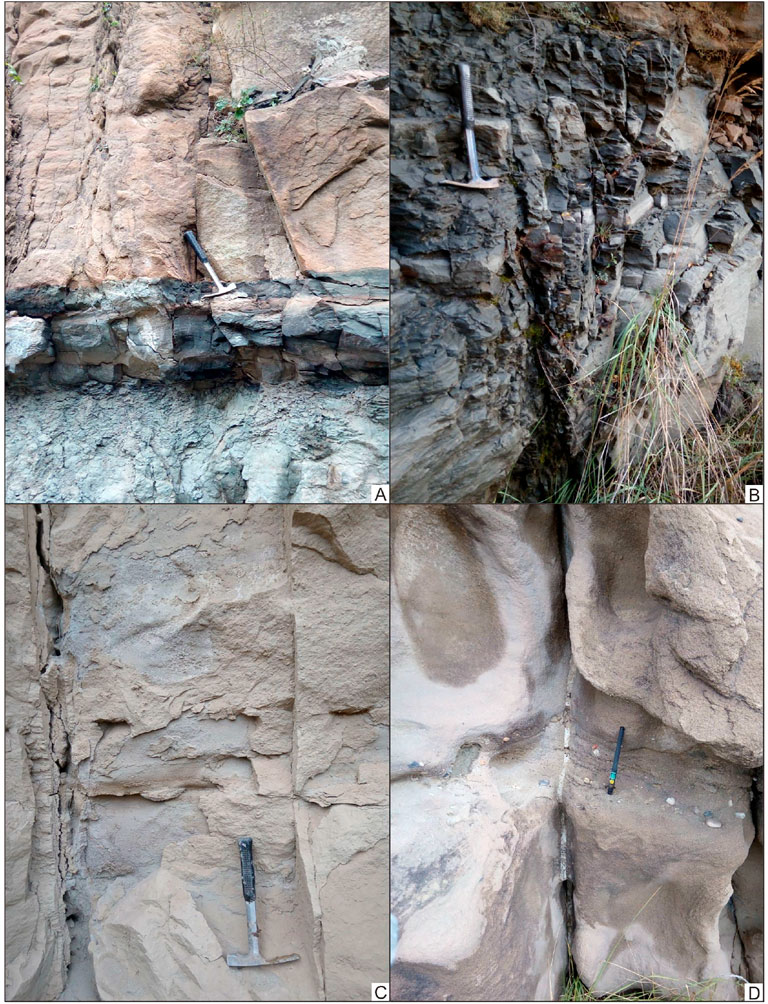
FIGURE 2. Structural fractures in the Yanchang Formation: photographs from the field. (A) Structural fractures are developed in sand–mud interbeds at Jiaxian, but fractures are basically not developed in the in the lower mudstone. (B) The shear fractures developed in mudstone at Suide have a small spacing and short extension distance. (C) The shear fractures developed in the sandstone at Xunyi have a large spacing and long extension distance. (D) This shear fracture developed in the dense sandstone at Dingbian is filled with calcite and has a width of 2.0 cm. See the locations in Figure 1.
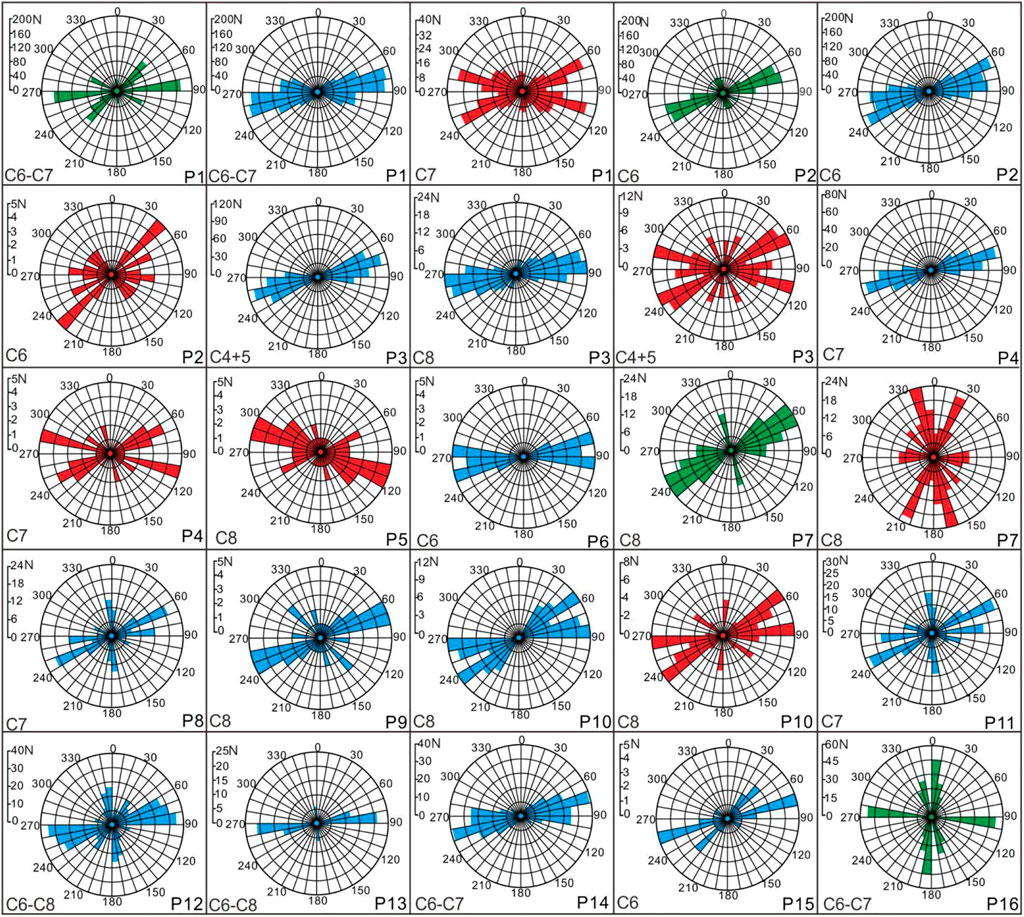
FIGURE 3. Fracture strike rose diagrams for different areas. Green represents fractures in field statistics, red represents fractures determined by core paleomagnetism, and blue represents fractures in imaging logging statistics. P1-P16 are the locations of the fracture observation points, and C4-C8 are the different oil-bearing formations of the Yanchang Formation. C4+5 = Chang 4+5 oil-bearing formations; C6 = Chang 6 oil-bearing formation; C7 = Chang 7 oil-bearing formation; C8 = Chang 8 oil-bearing formation. See Figure 1 for the P1-P16 locations. Some imaging logging and paleomagnetic data in the western Ordos Basin were provided by Fan et al. (2016).
Field observations, core statistics and imaging logging statistics show that the fracture orientation is basically consistent with the direction of the paleocurrent, and the relationship between them is linear (Figure 4). In the P3 area, the paleocurrent direction is ESE 105°, and the uniaxial compressive strength of the rock is the lowest in the E‒W direction (Figure 5). The anisotropy in the uniaxial compressive strength of the rock leads to the nondevelopment of SE‒NW-directed fractures in the Yanshanian period and the nondevelopment of NNE‒SSW-directed fractures in both groups of fractures in the Himalayan period. In the P2, P8 and P10 areas, the direction of the paleocurrent is NE 40°, and the uniaxial compressive strength of the rock is the lowest in the NE‒SW direction, which results in a group of undeveloped conjugate fractures in the Yanshanian and Himalayan periods (Figure 6). Anisotropy in the rock mechanics parameter plane is caused by the distribution of bedding or grain orientations in the rock developed by the paleocurrent, which is the main factor that determines the different degrees of fracture development in different directions.
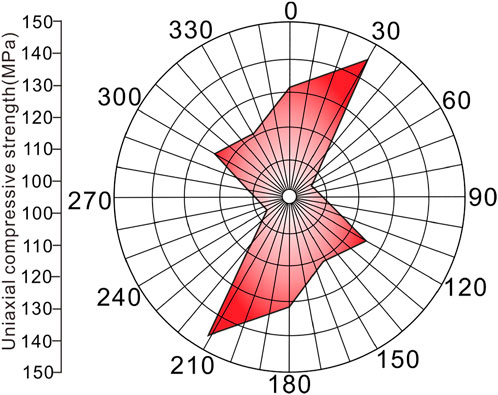
FIGURE 5. Uniaxial compressive strength of the rock in different directions for low-permeability sandstone in the P3 area (according to Tang et al., 2012).

FIGURE 6. Uniaxial compressive strength of the rock in different directions for low-permeability sandstone in the Longdong area (P2, P8, and P10) (according to Zeng et al., 2008b).
When the sediments in the study area come from a single source, a group of fractures with a small angle between the conjugate fracture and the source direction develops, while a group of fractures with a large angle between the conjugate fracture and the source direction does not develop (Figures 7A,B). The normal stress and shear stress curves of rocks under different confining pressures were fit, and the internal friction angle of tight sandstone in the study area is 40–45° (Liu et al., 2021). When there are two paleocurrent currents in the study area, both source directions affect the orientation of natural fractures. In the southern Ordos Basin, influenced by the direction of paleocurrent currents in the near N‒S direction, fractures in the near N‒S direction developed (Figures 8A,B). As the number of paleocurrent directions increases, the orientations of natural fractures become more complicated (Figure 8C).
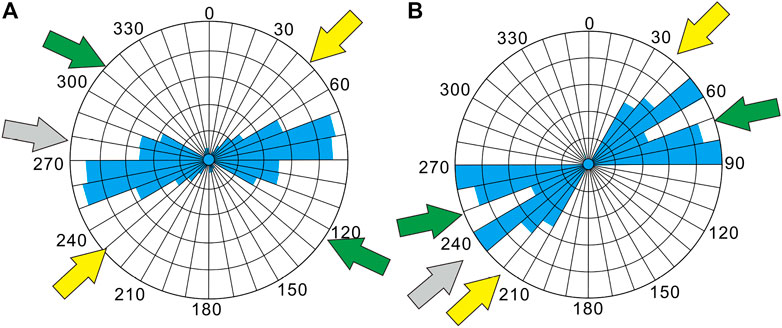
FIGURE 7. (A) The relationship between the strike of natural fractures and the direction of the paleocurrent and paleostress field in the western central Ordos Basin; (B) the relationship between the strike of natural fractures and the direction of the paleocurrent and paleostress field in the southwestern Ordos Basin. The yellow arrow is the direction of the maximum horizontal principal stress in the Himalayan period, and the blue arrow is the direction of the maximum horizontal principal stress in the Yanshanian period; the light gray arrow is the main paleocurrent direction, and the dark gray arrow is the secondary paleocurrent direction.
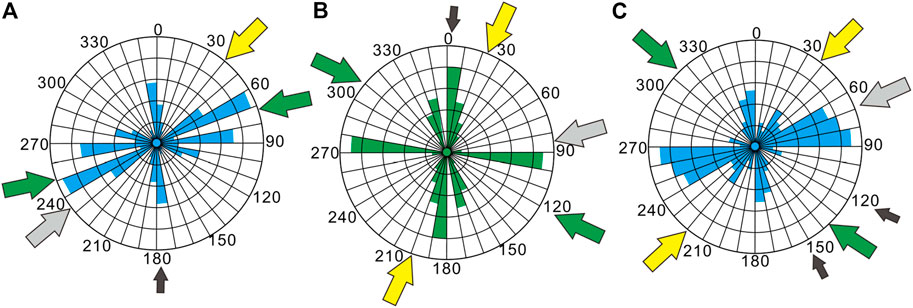
FIGURE 8. (A) The relationship between the strike of natural fractures and the direction of the paleocurrent and paleostress field in the southern Ordos Basin; (B) the relationship between the direction of the paleocurrent and paleostress field in the east central Ordos Basin; (C) the relationship between the strike of natural fractures and the direction of the paleocurrent and paleostress field in the southeastern Ordos Basin. The yellow arrow is the direction of the maximum horizontal principal stress in the Himalayan period, and the blue arrow is the direction of the maximum horizontal principal stress in the Yanshanian period; the light gray arrow is the main paleocurrent direction, and the dark gray arrow is the secondary paleocurrent direction.
5 Conclusion
In this paper, we present an example of a group of undeveloped conjugate fractures caused by paleocurrents. The main controlling factors of fracture development in the Ordos Basin are lithology, stratum thickness and tectonic stress. The fractures in the study area are mainly high-angle fractures, showing typical structural genetic characteristics. Due to the heterogeneity of reservoir rocks, conjugate fractures are characterized by one group of relatively developed fractures and another group of relatively weak fractures.
The direction of the paleocurrent results in anisotropy in the rock mechanics plane; the rock compressive strength parallel to the direction of the paleocurrent is the smallest, which means that a group of conjugate fractures did not develop in the Ordos Basin, and the direction of the paleocurrent led to undeveloped fractures. The main reason for the difference is the rock mechanics parameters in the same direction. When the differential stress at the basin margin is large, the tectonic stress is the dominant factor controlling the direction and path of fracture propagation, and conjugate fractures can be seen in the field profiles. In the Ordos Basin, the stress difference is small, and the anisotropy in the rock mechanics parameters of reservoirs affects the propagation of fractures, resulting in various degrees of fracture development in different directions.
The direction of the paleocurrent combined with the distribution of the paleostress field can be used to predict which group of conjugate fractures develop. Conversely, the direction of the paleocurrent can be inferred by combining the orientation of developed fractures with the distribution of the paleostress field.
Data availability statement
The original contributions presented in the study are included in the article/supplementary material, further inquiries can be directed to the corresponding author.
Author contributions
HY and JY contributed in writing, reviewing, and editing, datacuration, writing—original draft preparation; PC, CH, and PD contributed in formal analysis, validation, and reviewing.
Funding
This research was supported by the National Natural Science Foundation of China (Grant Nos. 41472092).
Conflict of interest
Author CH was employed by Tongren Zhongneng Natural Gas Co, Ltd.
The remaining authors declare that the research was conducted in the absence of any commercial or financial relationships that could be construed as a potential conflict of interest.
Publisher’s note
All claims expressed in this article are solely those of the authors and do not necessarily represent those of their affiliated organizations, or those of the publisher, the editors and the reviewers. Any product that may be evaluated in this article, or claim that may be made by its manufacturer, is not guaranteed or endorsed by the publisher.
Supplementary material
The Supplementary Material for this article can be found online at: https://www.frontiersin.org/articles/10.3389/feart.2022.1058768/full#supplementary-material
References
Chai, Y., and Yin, S. (2021). 3D displacement discontinuity analysis of in-situ stress perturbation near a weak faul. Adv. Geo-Energy Res. 5 (3), 286–296. doi:10.46690/ager.2021.03.05
Chen, C., Ji, G., Wang, H., Huang, H., Baud, P., and Wu, Q. (2022). Geology-engineering integration to improve drilling speed and safety in ultra-deep clastic reservoirs of the Qiulitage structural belt. Adv. Geo-Energy Res. 6 (4), 347–356. doi:10.46690/ager.2022.04.09
Fan, C. H., Li, H., Qin, Q. R., He, S., and Zhong, C. (2020). Geological conditions and exploration potential of shale gas reservoir in Wufeng and Longmaxi Formation of southeastern Sichuan Basin, China. J. Petroleum Sci. Eng. 191, 107138. doi:10.1016/j.petrol.2020.107138
Fan, C. H., Xie, H. B., Li, H., Zhao, S. X., Shi, X. C., Liu, J. F., et al. (2022)., 2022. China. Lithosphere, 8035106. doi:10.2113/2022/8035106Complicated fault characterization and its influence on shale gas preservation in the southern margin of the sichuan basin, China
Fan, J., Qu, X., Wang, C., Lei, Q., Cheng, L., and Yang, Z. (2016). Natural fracture distribution and a new method predicting effective fractures in tight oil reservoirs in Ordos Basin, NW China. Petroleum Explor. Dev. 43 (5), 806–814. doi:10.1016/s1876-3804(16)30096-9
Gong, L., Fu, X., Wang, Z., Gao, S., Jabbari, H., Yue, W., et al. (2019). A new approach for characterization and prediction of natural fracture occurrence in tight oil sandstones with intense anisotropy. Bulletin 103 (6), 1383–1400. doi:10.1306/12131818054
Gudmundsson, A. (2006). How local stresses control magma-chamber ruptures, dyke injections, and eruptions in composite volcanoes. Earth-Science Rev. 79 (1-2), 1–31. doi:10.1016/j.earscirev.2006.06.006
Gudmundsson, A., Simmenes, T. H., Larsen, B., and Philipp, S. L. (2010). Effects of internal structure and local stresses on fracture propagation, deflection, and arrest in fault zones. J. Struct. Geol. 32 (11), 1643–1655. doi:10.1016/j.jsg.2009.08.013
Guo, Y. (2016). Characteristics of tight reservoirs and reservoir enrichment in the triassic Yanchang Formation in the Ordos Basin. China: Petroleum Industry Press.
Hutchinson, J. W. (1996). Notes for a dcamm course. Lyngby: Technical University of Denmark.Stresses and failure modes in thin films and multilayers.
Jiang, L., Qiu, Z., Wang, Q., Guo, Y., Wu, C., Wu, Z., et al. (2016). Joint development and tectonic stress field evolution in the southeastern Mesozoic Ordos Basin, west part of North China. J. Asian Earth Sci. 127, 47–62. doi:10.1016/j.jseaes.2016.06.017
Ju, W., Shen, J., Qin, Y., Meng, S., Wu, C., Shen, Y., et al. (2017). In-situ stress state in the linxing region, eastern Ordos Basin, China: Implications for unconventional gas exploration and production. Mar. Petroleum Geol. 86, 66–78. doi:10.1016/j.marpetgeo.2017.05.026
Ju, W., Sun, W., and Hou, G. (2015). Insights into the tectonic fractures in the yanchang formation interbedded sandstone-mudstone of the ordos basin based on core data and geomechanical models. Acta Geol. Sin. - Engl. Ed. 89 (6), 1986–1997. doi:10.1111/1755-6724.12612
Larsen, B., Grunnaleite, I., and Gudmundsson, A. (2010). How fracture systems affect permeability development in shallow-water carbonate rocks: An example from the gargano peninsula, Italy. J. Struct. Geol. 32 (9), 1212–1230. doi:10.1016/j.jsg.2009.05.009
Laubach, S. E., Olson, J. E., and Gross, M. R. (2009). Mechanical and fracture stratigraphy. Bulletin 93 (11), 1413–1426. doi:10.1306/07270909094
Li, H., Tang, H., Qin, Q., Zhou, J., Qin, Z., Fan, C., et al. (2019). Characteristics, formation periods and genetic mechanisms of tectonic fractures in the tight gas sandstones reservoir: A case study of xujiahe formation in YB area, sichuan basin, China. J. Petroleum Sci. Eng. 178, 723–735. doi:10.1016/j.petrol.2019.04.007
Li, J., Li, H., Yang, C., Wu, Y., Gao, Z., and Jiang, S. (2022). Geological characteristics and controlling factors of deep shale gas enrichment of the Wufeng-Longmaxi Formation in the southern Sichuan Basin, China. Lithosphere 2022, 4737801. doi:10.2113/2022/4737801
Liu, C., Zhao, H., and Wang, F. (2005). Attributes of the mesozoic structure on the west margin of the ordos basin. Acta Geol. Sin. 79 (6), 747.
Liu, J., Chen, P., Xu, K., Yang, H., Liu, H., and Liu, Y. (2022a). Fracture stratigraphy and mechanical stratigraphy in sandstone: A multiscale quantitative analysis. Netherlands: Marine and Petroleum Geology. 145, 105891. doi:10.1016/2022/105891
Liu, J., Ding, W., Dai, J., Wu, Z., and Yang, H. (2018). Quantitative prediction of lower order faults based on the finite element method: A case study of the M35 fault block in the Western hanliu fault zone in the gaoyou sag, east China. Tectonics 37 (10), 3479–3499. doi:10.1029/2017tc004767
Liu, J., Ding, W., Xiao, Z., and Dai, J. (2019). Advances in comprehensive characterization and prediction of reservoir fractures. Prog. Geophys. 34 (6), 2283–2300.
Liu, J., Ding, W., Yang, H., and Liu, Y. (2021). Quantitative multiparameter prediction of fractured tight sandstone reservoirs: A case study of the Yanchang Formation of the Ordos Basin, central China. SPE J. 26 (05), 3342–3373. doi:10.2118/205495-pa
Liu, J., Mei, L., Ding, W., Xu, K., Yang, H., and Liu, Y. (2022b). Asymmetric propagation mechanism of hydraulic fracture networks in continental reservoirs. GSA Bull. doi:10.1130/B36358.1
Liu, J., Yang, H., Xu, K., Wang, Z., Liu, X., Cui, L., et al. (2022c). Genetic mechanism of transfer zones in rift basins: Insights from geomechanical models. GSA Bull. 134 (9-10), 2436–2452. doi:10.1130/b36151.1
Liu, S., and Yang, S. (2015). Upper triassic – jurassic sequence stratigraphy and its structural controls in the Western ordos basin, China. Basin Res. 12 (1), 1–18. doi:10.1046/j.1365-2117.2000.00107.x
Lyu, W., Zeng, L., Liu, Z., Liu, G., and Zu, K. (2016). Fracture responses of conventional logs in tight-oil sandstones: A case study of the upper triassic Yanchang Formation in southwest Ordos Basin, China. Bulletin 100 (9), 1399–1417. doi:10.1306/04041615129
Muehlberger, W. R. (1961). Conjugate joint sets of small dihedral angle. J. Geol. 69 (2), 211–219. doi:10.1086/626729
Palchik, V. (2006). Application of mohr–coulomb failure theory to very porous sandy shales. Int. J. Rock Mech. Min. Sci. 43 (7), 1153–1162. doi:10.1016/j.ijrmms.2006.03.007
Tang, X., Zeng, L., He, Y., Fan, J., Xu, W., Gong, L., et al. (2012). Effect of deposition and diagenesis on tectonic fractures of sandstone reservoirs with ultra-low permeability in jiyuan oilfield. J. Oil Gas Technol. 34 (4), 21–25.
Tao, S., Yuan, X., Hou, L., Zhu, R., Yang, F., Li, C., et al. (2016). Play types, geologic characteristics and exploration domains of lithological reservoirs in China. Petroleum Explor. Dev. 43 (6), 941–953. doi:10.1016/s1876-3804(16)30112-4
Wood, D. A. (2022). Predicting brittleness indices of prospective shale formations from sparse well-log suites assisted by derivative and volatility attributes. Adv. Geo-Energy Res. 6 (4), 334–346. doi:10.46690/ager.2022.04.08
Xu, L., Zhou, L., Zhang, Y., and Dang, B. (2006). Characteristics and tectonic setting of tectono-stress field of Ordos Basin. Geotect. Metallogenia 30 (4), 455–462.
Yao, J., Deng, X., Zhao, Y., Han, T., Chu, M., and Pang, J. (2013). Characteristics of tight oil in triassic Yanchang Formation, Ordos Basin. Petroleum Explor. Dev. 40 (2), 161–169. doi:10.1016/s1876-3804(13)60019-1
Zeng, L., Gao, C., Qi, J., Wang, Y., Li, L., and Qu, X. (2008a). The distribution rule and seepage effect of the fractures in the ultra-low permeability sandstone reservoir in east Gansu Province, Ordos Basin. Sci. China Ser. D-Earth. Sci. 51 (2), 44–52. doi:10.1007/s11430-008-6015-8
Zeng, L., and Li, X. (2009). Fractures in sandstone reservoirs with ultra-low permeability: A case study of the upper triassic Yanchang Formation in the Ordos Basin, China. Bulletin 93 (4), 461–477. doi:10.1306/09240808047
Zeng, L., Li, Z., Shi, C., Wang, Z., Zhao, J., and Wang, Y. (2007). Characteristics and origin of fractures in the sandstone reservoirs of ultra-low permeability of the upper triassic yancheng formation in the Ordos Basin. Acta Geol. Sin. 81 (2), 174–180.
Zeng, L., Zhao, J., Zhu, S., Xiong, W., He, Y., and Chen, J. (2008b). Impact of rock anisotropy on fracture development. Prog. Nat. Sci. 18 (11), 1403–1408. doi:10.1016/j.pnsc.2008.05.016
Zhao, J., Zhou, X., Lei, Q., Zhao, G., He, Y., Shi, J., et al. (2017b). Study on paleo-tectonic and present tectonic stress in chang 7 tight reservoir of Maling oilfield, Ordos Basin. J. Geomechanics 23 (6), 810–820.
Zhao, W. T., and Hou, G. T. (2017a). Fracture prediction in the tight-oil reservoirs of the triassic Yanchang Formation in the Ordos Basin, northern China. Pet. Sci. 14 (1), 1–23. doi:10.1007/s12182-016-0141-2
Zhao, X., Liu, L., Hu, J., Zhou, X., and Li, M. (2014). The tectonic fracture modeling of an ultra-low permeability sandstone reservoir based on an outcrop analogy: A case study in the wangyao oilfield of Ordos Basin, China. Pet. Sci. 11 (3), 363–375. doi:10.1007/s12182-014-0350-5
Keywords: conjugate fractures, paleocurrent direction, rock mechanics anisotropy, ordos basin, low-permeability sandstone
Citation: Yang H, Yu J, Chen P, Hu C and Dai P (2023) Development or absence of conjugate fractures in low-permeability sandstones. Front. Earth Sci. 10:1058768. doi: 10.3389/feart.2022.1058768
Received: 30 September 2022; Accepted: 08 November 2022;
Published: 17 January 2023.
Edited by:
Dadong Liu, China University of Petroleum, Beijing, ChinaCopyright © 2023 Yang, Yu, Chen, Hu and Dai. This is an open-access article distributed under the terms of the Creative Commons Attribution License (CC BY). The use, distribution or reproduction in other forums is permitted, provided the original author(s) and the copyright owner(s) are credited and that the original publication in this journal is cited, in accordance with accepted academic practice. No use, distribution or reproduction is permitted which does not comply with these terms.
*Correspondence: Jifeng Yu, yujifeng05@163.com
 Haimeng Yang
Haimeng Yang Jifeng Yu
Jifeng Yu Peng Chen2
Peng Chen2 